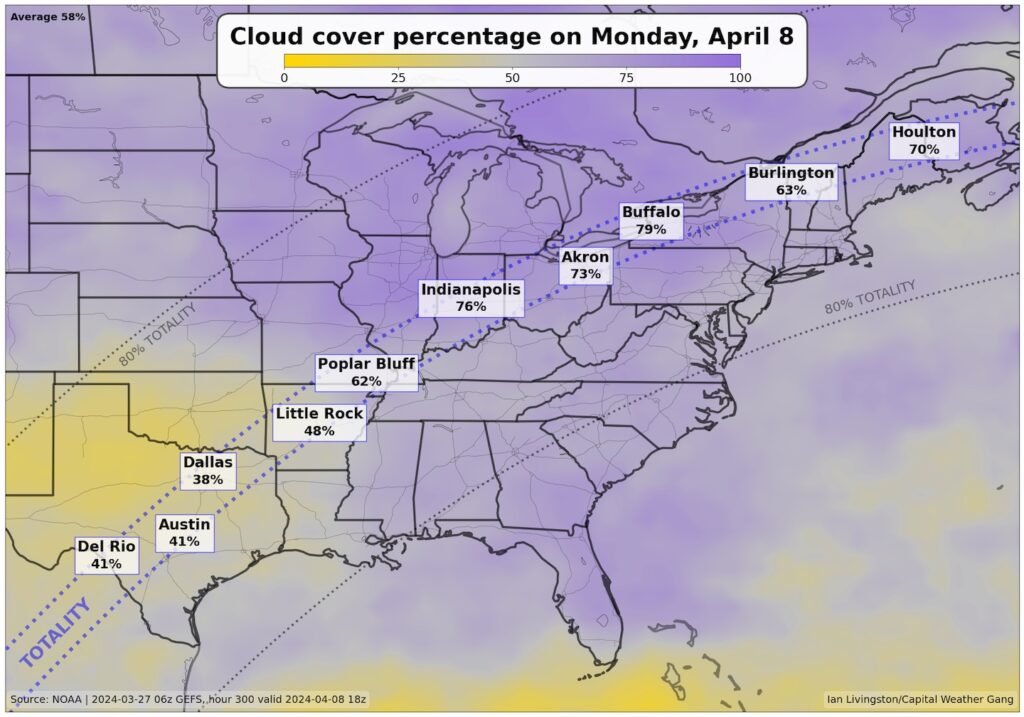Why are clouds so difficult to predict?
Clouds are one of the most difficult weather parameters to predict even just a few days in advance, let alone more than 10 days in advance.
Large storm systems aren't the only things that produce widespread cloud cover. These clouds are relatively easy to predict, especially within a few days. Smaller, weaker disturbances in the atmosphere can produce clouds as well, even though there is not enough moisture to form precipitation. On the other hand, the sky can go from completely cloudy to completely clear within just 80 miles of a front, but model forecasts for the front's location can be off by a factor of two a day or two ahead of time.
The challenge is that cloud cover often depends on processes that occur at very small scales in the atmosphere. It's so small that the model doesn't have enough detailed data to solve it accurately.
Why do I need to know what an “ensemble” is?
In general, we try to keep jargon to a minimum. However, for those invested in this prediction, it is worth learning what “ensemble” is and why it is important.
There are two main types of predictive models: deterministic models and ensembles.
Deterministic models are commonly encountered predictions. This is a single solution prediction. The temperature is X, the probability of precipitation is Y, and the cloud cover is Z. These forecasts are usually most accurate up to two to three days in advance.
For forecasts from a few days to about two weeks out, most meteorologists prefer to look at ensembles. These are essentially multiple runs of deterministic predictions. Each run or simulation slightly tweaks the initial weather observations input into the model to account for imperfections in both the observations and the model itself. Analyzing similarities and differences between multiple simulations gives forecasters a better idea of the range and probability of possible weather outcomes and overall forecast confidence. .
What does the firm forecast say for April 8th?
The image above is the deterministic model forecast for April 8th at noon. Many clouds will be visible throughout much of the total orbit, a band approximately 115 miles wide that stretches across the United States from Texas to Maine. Sometimes it's completely right, sometimes it's completely wrong. It takes too many days to do anything based on firm predictions.
What it shows is similar to the climatology, the average cloud conditions for this time of year, with clearer skies over Texas and increasing cloudiness as we head northeast. But there are also sunny spots in the Northeast, associated with an area of expected high pressure near the coast of the East Coast.
What does the ensemble show?
The image above shows an ensemble forecast of atmospheric pressure using the average of the predicted pressure from 30 simulations by the American Modeling System. In general, areas of low pressure (shown in shades of blue) tend to be cloudy, while areas of high pressure (shown in yellow and orange) tend to be sunny.
A significant number of individual simulations suggest low pressure and cloudy skies over a significant portion of the total path. Some suggest higher pressure and more clear skies in the eastern or northeastern part of the total path, but still show lower pressure in the western part of the total path, especially in areas of northern Texas.
The cloud cover forecast shown at the top of this article indicates that the low pressure location is far enough north of Texas that cloud cover could be limited if the simulation of the low pressure location is correct. Suggests.
Of course, such a wide deviation not only gives less confidence in the existence and location of the weather system, but also means that the models can be up to a day or two behind how the system will develop across the country.
Artificial intelligence weather forecasting startup Excarta has launched a solar eclipse tracker that provides cloud forecasts along the path of the solar eclipse.
The company is among several companies that have developed AI weather models that learn to recognize patterns in historical weather data to make predictions, whereas traditional models calculate complex mathematical equations that describe the physics of the atmosphere. This is one of the.
“This allows us to create highly accurate hourly global forecasts in minutes instead of hours,” Vivek Ramavajjala, CEO and founder of Excarta, said in an email. It is stated in “The increased speed and cost can also be used to create ensembles of weather forecasts, which are important in quantifying forecast uncertainty beyond a few days.”
The company's predictions can be up to 20 percent more accurate than traditional models, according to a company news release.
Below are the AI model's current predictions for several cities in the path of the total solar eclipse at its peak.
- Dallas: Cloud cover 53% (uncertainty +/-20%).
- Little Rock: Cloud cover 58% (+/- 15% uncertainty).
- Indianapolis: Cloud cover 54% (+/- 19% uncertainty).
- Cleveland: Cloud cover 55% (+/- 19% uncertainty).
- Buffalo: Cloud cover 53% (+/- 19% uncertainty).
- Burlington, VA: 47% cloud cover (uncertainty +/- 22%).
(An uncertainty number means, for example, that we predict there is a 33% to 73% chance of cloud cover in Dallas.)
For those hoping for sunny skies, will the weather forecast be off to a great start? Not exactly. But it will take at least a few days before cloud forecasts can no longer be taken seriously, and the forecast may not be very reliable until just a day or two before April 8.
The Washington Post will be releasing its own solar eclipse cloud forecast tracker on Friday, so keep an eye out for it.


